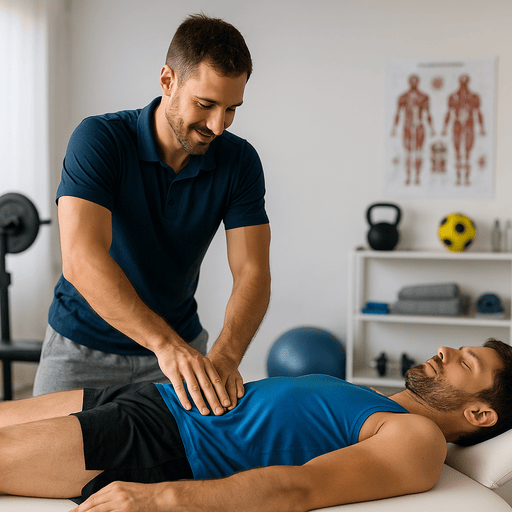Recovery isn’t just about rest — for many athletes, intelligent recovery means blending hands-on care with structured rehab. In this article, we examine how massage therapy can play a valuable part in a comprehensive physiotherapy program, and why combining both approaches often delivers the best long-term results.
How Sports Injuries Often Build Over Time
Muscle Overuse and Micro-Trauma
Whether you’re a regular runner, swimmer, cyclist, or team-sport athlete, repetitive training places continuous stress on muscles and joints. Over time, that load can cause micro-tears in muscle fibres. Left unaddressed, these micro-tears may lead to stiffness, tightness, reduced flexibility and compensatory movement patterns — all of which raise the risk of more serious injury.
Biomechanics, Load Management and Delayed Recovery
In many cases, underlying issues like poor biomechanics, muscle imbalance or joint stiffness are more to blame for recurring discomfort than a single “injury.” A physiotherapist’s assessment can reveal these underlying problems. Without correction, muscles and joints remain under strain, and recovery becomes a repeating loop. That’s why recovery needs more than just passive rest — it requires targeted intervention, correction and ongoing maintenance.
What Massage Therapy Offers to Athletes
Relief from Tightness and Improved Circulation
Massage therapy has a long history in sports recovery for good reason. It can help ease muscle tightness, improve blood flow, and encourage better movement patterns. After a heavy training session, focused soft-tissue work may reduce soreness, flush out metabolic waste, and help muscles relax. For athletes undergoing heavy load cycles, that immediate relief can feel crucial — and often helps sustain training intensity.
Support for Range of Motion and Flexibility
Tight muscles or restricted fascia limit range of motion and can compromise technique — whether you’re sprinting, jumping, swinging a racquet, or lifting weights. Regular massage therapy can maintain mobility, ease muscular restrictions, and support smoother movement. Over time, this can translate into improved athletic performance and reduced strain on joints and connective tissue.
Why Physiotherapy Matters — and How It Complements Massage Therapy
Accurate Diagnosis and Underlying Issue Correction
While massage therapy can relieve immediate muscle tension and discomfort, it may not fix root causes such as joint misalignment, muscle imbalance, or flawed movement patterns. A physiotherapist will look beyond symptoms — assessing biomechanics, joint mobility and function, muscle strength, and movement mechanics. This ensures any treatment addresses the cause of discomfort, not just the symptom.
Creating a Structured, Sustainable Recovery Plan
For lasting results, athletes benefit from a combined strategy: massage therapy to assist recovery, plus physiotherapy-guided rehab to build strength, mobility, and resilience. Through guided exercises, soft-tissue work, mobility drills and functional training, a structured recovery plan helps prevent recurring injuries, supports performance, and enhances long-term musculoskeletal health. Clinics offering both disciplines provide a holistic pathway back to sport and activity.
Here’s a helpful resource for such integrated care: Next Wave Therapy’s trusted massage therapy support — a model where physiotherapy and therapeutic massage work side-by-side for recovery and performance enhancement Next Wave Therapy+1
Real-World Examples: Athletes Taking an Integrated Approach
Runner with IT Band Tightness
A recreational runner noticed persistent tightness along the outer thigh and knee after increasing mileage. A regular deep-tissue massage helped ease muscle tension — but discomfort kept returning. After a physiotherapy assessment, the underlying cause was traced to weak hip stabilizers and pelvis joint tightness. A plan combining massage therapy, targeted hip strengthening, and mobility drills helped the runner return to pain-free training and avoid repeat injury.
Junior Basketball Player After Ankle Sprain
A young athlete sprained an ankle during play. Initial swelling and discomfort subsided with rest and some massage therapy — but movement still felt “off.” Physiotherapy revealed reduced ankle joint mobility and calf weakness. With physiotherapy-guided rehab plus gentle soft-tissue therapy, the player regained full function, improved jumping and agility, and lowered risk of re-injury.
When Massage Alone Isn’t Enough
Not all discomfort is muscular: nerve irritation, joint injuries or structural issues (like cartilage damage) require professional evaluation. In cases of sharp pain, recurring sprains, instability or restricted joint function, physiotherapy — not massage alone — is essential. Massage therapy may still play a role in recovery, but only as part of a broader, clinically-guided plan.
Practical Tips for Everyday Athletes
How Often to Book Massage Therapy
- During heavy training or competition periods: Consider massage every 1–2 weeks to support muscle recovery and circulation.
- During off-season or light training phases: Massage every 3–4 weeks may suffice to maintain flexibility and tension relief.
- After injury or rehabilitation: Work with a physiotherapist to determine optimal timing — sometimes massage is best introduced after early rehab has begun to avoid interfering with healing.
What to Ask Before Booking a Session
- Does the clinic integrate physiotherapy and massage therapy under one roof?
- Will the session target functional improvement (mobility, strength, posture), or just temporary muscle relief?
- Are therapists aware of your sport type, training load and injury history?
Pre- and Post-Massage Suggestions
- Always warm up or do light stretching before a deep-tissue massage to avoid shock to cold muscles.
- Stay well hydrated before and after massage therapy — good circulation supports recovery.
- Ease back into training gradually after treatment, especially after deep muscle release.
During lighter sessions (e.g. soft-tissue maintenance), gentle stretching or mobility work afterwards may help preserve gains in range of motion.
For more guidance on long-term recovery and training habits worth adopting, check this fitness advice piece on our site: fitness tips worth using in everyday training.
If you’ve dealt with recurring pain or want sustainable recovery strategies rather than quick fixes, you may find value in reading about strategies for reducing pain during recovery.
Conclusion: Why Sustainable Recovery Means Team-Based Care
Massage therapy offers real benefits — from easing post-training tension to improving circulation and flexibility. But when sports load, repetitive movements, and biomechanical strain are involved, massage alone may only provide short-term relief. A combined approach — integrating physiotherapy for diagnosis, rehab and structural correction — increases the likelihood of lasting recovery, better performance and fewer recurring injuries.
For athletes and active individuals, holistic care involving both hands-on therapy and structured rehabilitation is often the key.



